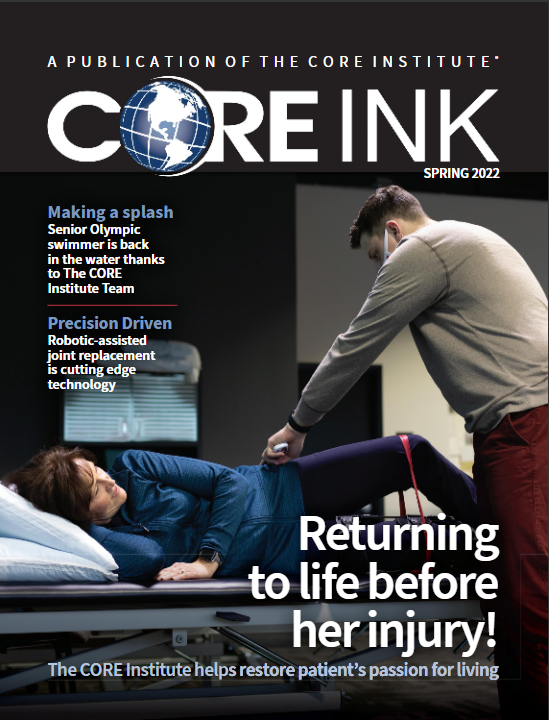The sounds and smells of our age-old national pastime fill the air as the ‘boys of summer’ take the field. But outside major league ballparks, weekend warriors, Little Leaguers and other competitors are also working hard to fine-tune their game. In baseball, arm injuries are increasingly common, and certain leg injuries can plague players, too. Here, two medical experts at The CORE Institute talk about how to prevent and treat some of the most common baseball injuries.
Arm Injuries to Watch For
The shoulders and elbows are the two most vulnerable areas of the arm for baseball players, thanks to the game involving repetitive throwing or swinging motions. In warm-weather states like Arizona, the mild climate can also be a problem, as the weather allows for more opportunities to play throughout the year and less arm rest, explains John Kearney, MD, a sports medicine specialist at The CORE Institute, in Arizona. Without rest, stabilizing muscles in the back weaken, creating poor throwing mechanics, putting stress on the labrum, rotator cuff and elbows, Dr. Kearney said: “Once you have those poor mechanics then you start getting the serious injuries.” Here are the three most common arm injuries for baseball player:
- Rotator cuff stress: The vital rotator cuff tendons help the top of the humerus (the long arm bone) rest securely inside the shoulder socket. With
repeated throwing, these tendons become strained and can eventually tear. Symptoms: Players often complain of a dull, persistent ache. - Labrum tears: Cartilage known as the labrum wraps around the shoulder socket, improving stability and allowing for a wide range of motion. With repetitive throwing, the labrum can eventually tear. Symptoms: Players will feel a deep, achy pain within the shoulder.
- Ulnar Collateral Ligament injury: This ligament is a tissue band that holds the bones of the elbow together. Unfortunately, with repetitive overhead throwing motions, it can eventually tear, too. The reconstructive Tommy John surgery may be required, which could be career altering. Symptoms: Players feel a pop after they throw, along with arm pain.
Preventing Arm Injuries
Dr. Kearney offers the following prevention tips:
- Don’t throw more than six to eight months out of the year. Play different sports to work a variety of muscle groups.
- Rest proactively and plan breaks throughout the year.
- When you come back from a break, take three weeks to one month to transition into full-speed throwing. Many injuries occur right after a rest period, Dr. Kearney noted.
Arm Injury Treatment
World-class care starts with a proper diagnosis. It’s important to work with a highly-experienced orthopedic professional trained in these injuries. “There are some pains that are absolutely fine to work through and play through, others that aren’t; a specialist knows that,” Dr. Kearney added. If injured, a period of rest is most often the first prescription, followed by physical therapy and work with a throwing specialist. If an MRI reveals a significant tear, surgery may be required, which would be followed by rest and physical therapy as well.
Leg Injuries to Watch For
Less common than arm injuries are ankle sprains or fractures and Anterior Cruciate Ligament (ACL) and Medial Collateral Ligament (MCL) strains and tears in the knee, explains William Kesto, MD, a sports specialist with The CORE Institute in Michigan. “These injuries are less frequent (than arm injuries), but anything can happen when you’re fielding or running the bases,” he said. Here’s what happens when these injuries occur:
- Ankle sprains: Here, the ankle joint’s ligaments stretch and tear, often as a result of an awkward twist or rolling motion. It could happen while sliding into a base or running.
- Knee injuries: The ACL and MCL are stabilizing ligaments that allow a person to pivot and rotate. Injuries usually occur when an athlete sharply twists or switches directions. Many players hear a popping noise and experience pain that does not subside after 24 to 48 hours.
Preventing Leg Injuries
Dr. Kesto offers the following prevention tips:
- For ankles, train your lower leg muscles, including the calf and the muscles around the foot that control ankle stability such as the tibialis posterior and tibialis anterior. This can be done with ankle raises, calf extensions and using balance boards.
- For knees, make sure hamstrings are properly stretched and train both the quadriceps and hamstrings equally in the upper leg to prevent overuse injuries, such as muscle strains.
Treating Leg Injuries
Ankle sprains can frequently be resolved with two to six weeks of rest, depending on their severity. Easing your way back into play is always advised, too. If there are repetitive ankle sprains, some athletes may require surgery. ACL and MCL tears are rated on a one to three scale, the higher the number the worse the tear is. “A small sprain can be treated nonoperatively with rest and rehabilitation, but severe sprains can lead to an unstable knee and may require surgical treatment,” Dr. Kesto added.
Questions about your sports injury? Schedule an appointment to help keep your life in motion.
SUBSCRIBE TO CORE INK NEWSLETTER
Sign up to receive stories and information from The CORE Institute, including expertise from our providers and news about the latest technology advancements helping our communities.

